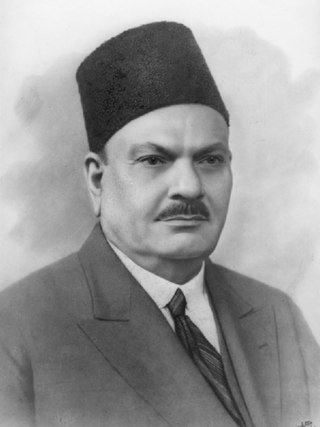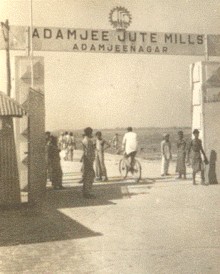
East Pakistan was the eastern province and one of two exclaves of Pakistan between 1955 and 1971, covering the territory of the modern country Bangladesh. The province was restructured and renamed from East Bengal, which, in modern times, is split between India and Bangladesh. Its land borders were with India and Burma, with a coastline on the Bay of Bengal. East Pakistanis were popularly known as "Pakistani Bengalis"; to distinguish this region from India's state West Bengal, East Pakistan was known as "Pakistani Bengal". In 1971, East Pakistan became the newly independent state Bangladesh, which means "country of Bengal" or "country of Bengalis" in Bengali language.

Narayanganj District is a district in central Bangladesh which is a part of the Dhaka Division. It is the smallest district in Bangladesh. It is home to the ancient city of one of the oldest industrial districts in the country. The district lies on the banks of the Shitalakshya River and the Meghna River. It is an industrial hub and plays an important part in the country's jute trade, plant processing and sector. It is nicknamed the "Dundee of Bangladesh" due to the presence of many jute mills.
The jute trade is centered mainly around India's West Bengal and Assam, and Bangladesh. The major producing country of jute is India and biggest exporter is Bangladesh, due to their natural fertile soil. Production of jute by India and Bangladesh are respectively 1.968 million ton and 1.349 million metric ton. Bengal jute was exported to South East Asia from the 17th century by the Dutch, French and later by other Europeans.

The Partition of Bengal in 1947, also known as the Second Partition of Bengal, part of the Partition of India, divided the British Indian Bengal Province along the Radcliffe Line between the Dominion of India and the Dominion of Pakistan. The Bengali Hindu-majority West Bengal became a state of India, and the Bengali Muslim-majority East Bengal became a province of Pakistan.
A jute mill is a factory for processing jute. There is evidence of jute fibre extraction dating back to the Han Dynasty, with a fragment of jute paper being discovered in Dunhuang, in the Gansu Province. The first known mechanical jute mills are believed to have been converted Flax mills, the oldest possibly being establish in Dundee, after a contract was agreed with the East India Company, for the supply of jute as a substitute for then scarce flax, in 1820. By the mid 1800s jute mills were being established in British India, George Acland's Mill of 1855, at Rishra, being the oldest. The world's largest jute mill was the Adamjee Jute Mills at Narayanganj in Bangladesh, which closed all operations in 2002.

Shitalakshya River is a distributary of the Brahmaputra. A portion of its upper course is known as Banar River or Banor River. In the Shitalakshya's initial stages, it flows in a southwest direction and then east of the city of Narayanganj in central Bangladesh until it merges with the Dhaleswari near Kalagachhiya. The river is about 110 kilometres (68 mi) long and at it widest, near Narayanganj, it is 300 metres (980 ft) across. Its flow, measured at Demra, has reached 74 cubic metres per second (2,600 cu ft/s). It remains navigable year round. The Shitalakshya flows through Gazipur district forming its border with Narsingdi for some distance and then through Narayanganj District.
Adamjee Group of Companies is a conglomerate company based primarily in Karachi, Pakistan. The group was headed by Sir Adamjee Haji Dawood.

Sir Adamjee Haji Dawood Bawany was a Pakistani businessman and philanthropist who founded Adamjee Group. He was also an activist in the Pakistan Movement.

The 1964 East Pakistan riots refer to the massacre and ethnic cleansing of Bengali Hindus from East Pakistan in the wake of an alleged theft of what was believed to be the Prophet's hair from the Hazratbal shrine in Jammu and Kashmir in India. The salient feature of the pogroms was its urban nature and selective targeting of Bengali Hindu owned industries and merchant establishments in the capital city of Dhaka. This resulted in unending waves of Bengali Hindu refugees in neighbouring West Bengal. The refugee rehabilitation became a national problem in India, and hundreds of refugees were resettled in Dandakaranya region of Odisha & Madhya Pradesh.
Mohammad Osman Ali was a founding member of the Awami Muslim League and a member of the East Bengal Legislative Assembly.
Siddhirganj, is one of the oldest industrial cities of Bangladesh. It is located in the bank of Shitalakshya River, Narayanganj. The Siddhirganj Industrial Zone has more than 15 thousand factories and industrial establishments. Adamjee Jute Mills was established in Siddhirganj in 1951 and was once the largest jute mill in the world. This city is also one of the largest exporter in the country. In 2018–2019, the Adamjee export processing zone in Siddhirganj exported more than 4 billion US dollars' worth of goods.
Narayanganj Railway Station (Bengali: নারায়ণগঞ্জ রেলওয়ে জংশন) is located in Narayanganj District, Bangladesh. The station is the main and populated station of Narayanganj city.

The Port of Narayanganj is a river port in Narayanganj, Bangladesh. It is one of the oldest and busiest river ports in Bangladesh; and one of the major ports of the Bengal delta. The port is located on the Shitalakshya River. The port area is home to numerous industries.
M Anwarul Azim was a Bengali industrial administrator who was killed in the Bangladesh Liberation war. He was awarded Independence Day Award in 2018 posthumously by the Government of Bangladesh.

Nishat Group is a Pakistani multinational conglomerate company which is based in Lahore, Pakistan. The company was founded by Pakistani business magnate Mian Muhammad Yahya in 1951. Mian Muhammad Mansha is the current chairman of the group.
The Acland Mill was the first jute mill established in India. The mill was established in 1855 by British entrepreneur George Acland and Bengali financier Babu Bysumber Sen in Rishra, Bengal Presidency, British India.
The jute industry is a historically and culturally important industry in Bangladesh dating back to during the growth of the East India Company in the Indian subcontinent. Despite once being one of the country's biggest industries and major export items, the jute industry has declined since the 1970s. Exports have fallen as other countries grow jute independently, decreasing the demand for jute to be exported, and other products like plastics and hemp find more widespread use.

Mohammad Abdus Sattar, known as M. A. Sattar, was a prominent Bangladeshi business magnate and politician. He was the founding chairman and managing director of Sattar & Company Ltd., Sattar Jute Mills Ltd., Hasna Shipbuilding & Navigation Ltd., and Rangpur Industries Ltd. In the 1980s, Sattar held several cabinet ministry positions, elected as a Member of Parliament twice, and was Chief Whip in President Ershad's Government from 1988 to 1990.
Mohammad Keramat Ali was a Pakistani Bengali entrepreneur, philanthropist and politician. He was a member of the 4th National Assembly of Pakistan as a representative of East Pakistan.










